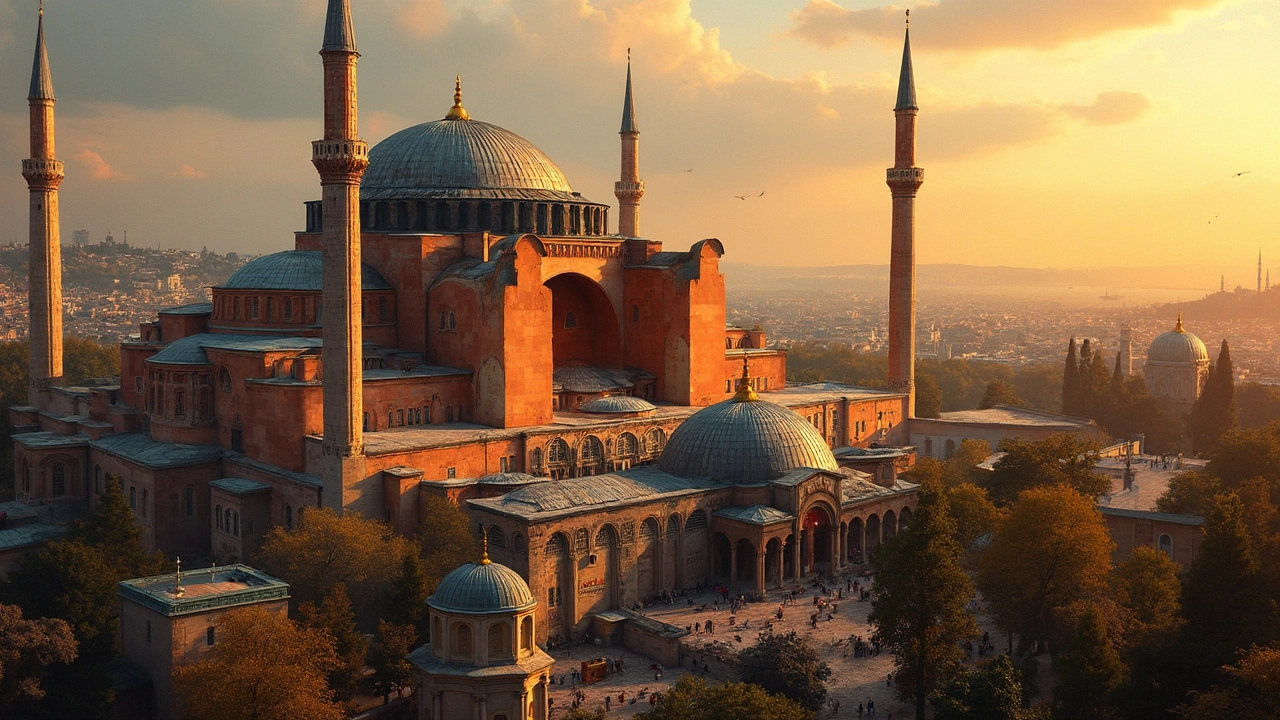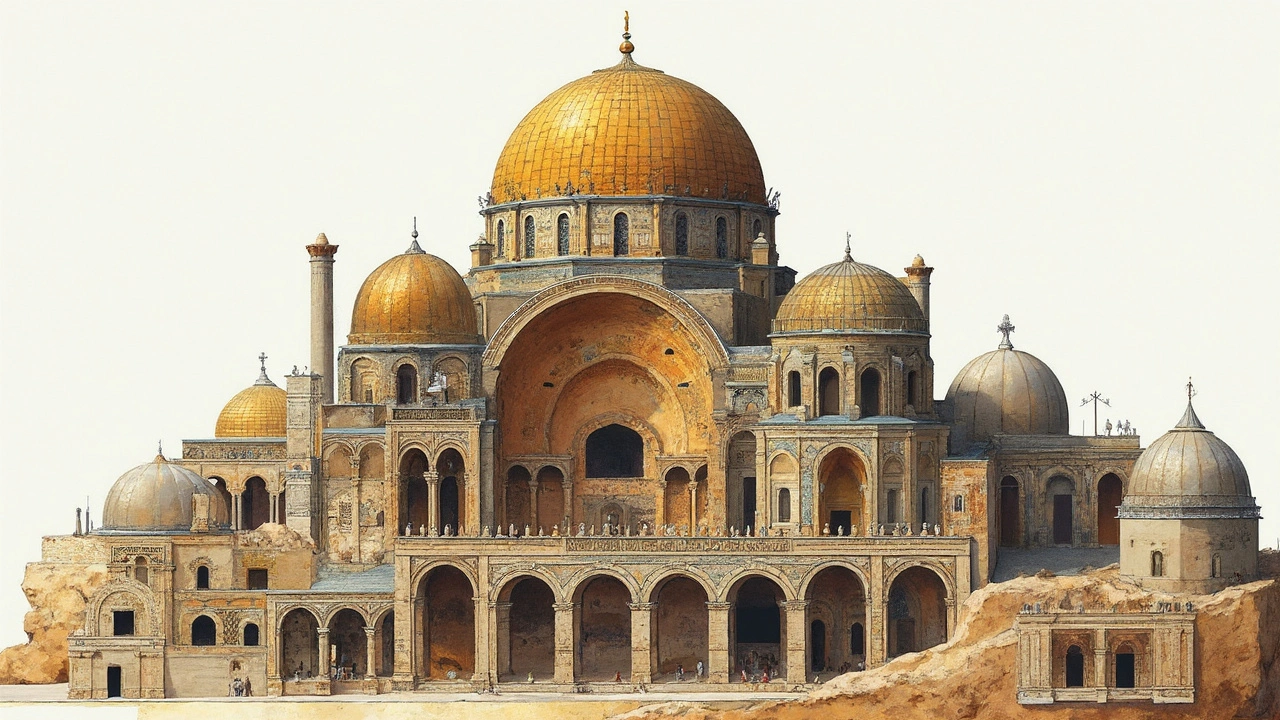Byzantine Architecture: The Birth of a New Era in Construction
 Apr, 12 2025
Apr, 12 2025
Ever wonder how architectural styles from the past could still leave us in awe today? Byzantine architecture is a prime example. It emerged during the Byzantine Empire, blending the grandeur of Roman buildings with Eastern influences, creating something entirely fresh and inspiring.
This style didn't just stop at grand-looking buildings; it introduced groundbreaking construction techniques. Picture massive domes, like the ones in the Hagia Sophia, that seem to float effortlessly. They didn’t just look good; they were engineering marvels of their time.
Byzantine architecture is more than just old buildings; it’s about the creative shifts that shaped how we build today. Recognizing its roots and innovations gives us a clearer picture of architecture’s evolution. Stick around to find out more about how this era changed the game, leaving a legacy that still influences builders and architects worldwide.
- Origins of Byzantine Architecture
- Key Features and Innovations
- Famous Byzantine Structures
- Cultural Impact and Legacy
Origins of Byzantine Architecture
Byzantine architecture kicked off in the 4th century AD when Constantine the Great moved the Roman Empire's capital to Byzantium, later renamed Constantinople. This shift wasn’t just a change in location; it was the beginning of a cultural fusion that sparked a whole new era in construction.
The brilliance of Byzantine architecture lies in its blending of Roman engineering skills with rich Eastern aesthetics. Think of it like a collaboration between two architectural giants—the stark efficiency of Roman designs meeting the intricate, decorative elements from the East. This concoction gave birth to structures that were both functional and fantastical.
One of the secrets to its innovation was the use of pendentives, which are essentially curved triangles that connect a dome to a square base. This architectural breakthrough allowed for the construction of larger and more daring domes, paving the way for buildings like the Hagia Sophia.
Moreover, construction during this time wasn't just about getting things up quickly. Builders were urged to consider both aesthetics and spirituality, resulting in stunning mosaics and iconography that adorned many of their churches and public buildings.
The development of Byzantine architecture was not an overnight event. It took centuries of exchanges, gains from conquered lands, and continuous experimentation. By the time Justinian I came to power in the 6th century, this style was in full swing, as evident in the iconic architecture from his era that still stands today.
Key Features and Innovations
Byzantine architecture isn't just about impressive facades; it's about the clever innovations that changed how buildings were constructed. At its core, this style took inspiration from the Roman Empire but gave it a new twist, blending both Roman and Eastern elements.
One standout feature of Byzantine architecture is its use of domes. The architects of the time were pioneers, making previously unimaginable structures possible. The Hagia Sophia is a prime example, showcasing a massive dome that seems to defy gravity. This effect was achieved through the use of pendentives—curved triangles that connect square bases to round domes, distributing the weight more evenly. This small but vital innovation enabled the creation of large open spaces, a concept that architects hadn't fully exploited before.
Another notable aspect was the extensive use of mosaics. Instead of plain walls, Byzantine churches and buildings featured intricate mosaics that depicted religious scenes and figures, adding a layer of artistry to the structure's spiritual purpose. These mosaics weren't just eye candy; they were a means of storytelling in a largely illiterate society.
Windows were also a big deal because they allowed light into vast interior spaces. The way light played through the mosaic's colors brought walls and ceilings to life, creating an ethereal atmosphere. This use of natural lighting was both practical and spiritual, enhancing the experience of the space.
Let’s also talk materials. Byzantine builders often used bricks and mortar due to their affordability and ease of moldability. This choice didn’t just cut costs; it spurred a broad reach of architectural innovation, essentially democratizing grand design elements that could now be part of many buildings.
While the lush decorations and pragmatic approaches defined the era, the aesthetic appeal and structural genius of Byzantine construction remain influential today, even if you won't find many modern buildings topped with a grand dome or walls adorned with vibrant mosaics.

Famous Byzantine Structures
When you think of Byzantine architecture, a few iconic buildings come to mind immediately. These structures didn't just serve practical purposes; they became symbols of cultural prowess and innovation.
First up is the Hagia Sophia in Istanbul, which started as a cathedral in 537 AD. This massive monument is famous for its enormous dome, a true marvel of engineering for its time. The design made it look like the dome was floating, which baffled architects and onlookers alike. The building has since transitioned through different roles over the years, including being a mosque and now a museum.
Another remarkable structure is the Basilica of San Vitale in Ravenna, Italy. Completed in the 6th century, this church is a stellar example of the intricate mosaics that are a hallmark of Byzantine design. The detailed artwork tells religious stories that have been captivating visitors for centuries.
Then there's the Church of the Holy Apostles in Thessaloniki. Though the original structure was altered and rebuilt over time, its foundation and core design continue to inspire new generations of builders. What makes it stand out are the stunning interior frescoes and the use of domes and arches to define the spaces within.
These structures are more than just old landmarks. They’re living proof of how Byzantine architecture changed the game in the world of construction, blending beauty with ingenuity. They stand as a reminder of an era that prioritized not just the functional but the awe-inspiring.
Cultural Impact and Legacy
When it comes to cultural influence, Byzantine architecture really went the extra mile. It wasn’t just about building impressive structures; it was about shaking up how people thought about design and construction. The effects are still being felt today, adding a rich tapestry to modern architectural stories.
One of the most noticeable impacts was in religious architecture. Churches all over Eastern Europe, the Middle East, and even some parts of Western Europe started mimicking Byzantine styles. The signature domes, rich mosaics, and intricate details became a must-have for many religious buildings, grounding them in spiritual and artistic significance.
Then there's the influence on art and culture. The use of colorful mosaics wasn't just about decoration; it was a storytelling tool. These artworks depicted religious figures and stories, becoming a visual Bible for those who couldn’t read in that era. It effectively blended art and function in ways people hadn’t seen before.
Byzantine architecture also set benchmarks for engineering prowess. The innovation didn’t just stop with stunning visuals. Think about the structural breakthrough of pendentives that allowed circular domes to sit upon square bases—this was cutting-edge technology back then and set the stage for future architectural developments. Folks were awestruck by these achievements and inspired to push the limits in their own projects.
Fast forward to the Renaissance, and you’ll notice its legacy seeping into the grand designs of that time. Architects began revisiting these ancient techniques, merging them with their own innovations to create stunning works that still stand. It’s like Byzantine speed-dating with modern styles, resulting in unique, unforgettable architecture.
Finally, here’s a bit of fun trivia: some scholars have noted that even the iconic onion domes, often seen in Russian architecture, have roots in the Byzantine influence. These domes don’t just scream unique design but carry the history of a bygone empire echoing through time.
The lasting impact of the Byzantine way of building was that it didn’t just construct buildings; it changed the blueprint for cultural expression and innovation. That’s a legacy worth noting, don’t you think?